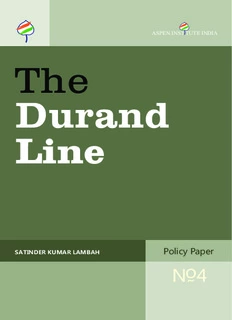
The Durand Line - Ananta Aspen Centre PDF
Preview The Durand Line - Ananta Aspen Centre
ASPENINSTTUTEINDIA The Durand Line Policy Paper SATINDER KUMAR LAMBAH N 4 õ The Durand Line SATINDER KUMAR LAMBAH ASPENINSTTUTEINDIA 2P,SECTOR31,GURGAON–122001(HARYANA) THEDURANDLINE|LAMBAH Foreword A spenInstituteIndia(AII)promotesvalues-basedleadership,opendialogue andcross-sectoroutreachbyengagingthecivilsociety,government,private sector,andotherkeystakeholdersonissuesrelatedtoIndia'sdevelopment. Itinvitesindustrial,economic,financial,political,socialandculturalleaderstodis- cuss these issues in settings that encourage frank and open dialogue. The Institute focusesonthemostimportantproblemsandchallengesfacingsociety,thebusinesscom- munityandtheindividualinIndia. TheAspenInstituteIndiaorganizesfivetypesofprogrammes: » OutreachSeminars » PolicySeminars » LeadershipSeminars » IdeasIndia » StrategicDialogues(incooperationwithCII) Whileeachisdistinctivewithauniquesetofgoals,theyallsharetheultimateaimof promotingawareness,dialogue,andactiononissuesessentialforajustandprosperous Indiansociety. AspenInstituteIndia(AII)initsendeavortocreatepublicawarenessandpromoteideas andpoliciesthatwillenhanceIndia’sgrowthinthefuture,isstartingaseriesofPolicy PaperswhichwillfocusonthevariousissuesrelatedtoIndia’sdevelopmentandstrate- gicinterests.Thispaperisthefourthintheseries. | September2011 --------------------------------------------------------------------------------------- Theopinionsexpressedinthispublicationaretheauthors’ownanddonotreflecttheviewsofAspen InstituteIndia |Thispublicationisintendedforprivatecirculationonly| Copyright © Aspen Insti- tuteIndia 2011 | PublishedinNewDelhi ~02~ Aii|POLICYPAPERSERIES|Nõ4 Contents I Introduction..............................................................................................04 II BriefSketchoftheDurands....................................................................04 III LandscapeoftheAreaanditsInhabitants,thePashtuns....................05 IV PressuresontheAmir..............................................................................07 V DurandAgreement..................................................................................08 VI IssuesinDelimitationandDemarcationofthe‘FrontierLine’..........10 VII Conversionof‘FrontierLine’of1893to‘Frontier’in1919...................13 VIII Pakistan’sPositionontheDurandLine.................................................15 IX Afghanistan’sPositionontheDurandLine..........................................18 X Pak-AfghanRelations..............................................................................22 XI IndianStandontheDurandLine...........................................................24 XII SummingUp.............................................................................................25 Annexure-I:TextoftheAgreement..........................................................................27 ~03~ THEDURANDLINE|LAMBAH Introduction I. Inanattempttosecureordepictbordersorfrontiersseverallinesweretobe drawninIndiaandelsewhereduringtheperiodoftheBritishEmpire.Thesewere toincludetheDurandLine(1893)thatwastorepresentthelimitsoftherespec- tive spheres of influence of British India and Afghanistan in the Pakhtun belt; theJohnson-ArdaghLine(1895)whichwastoformthebasisfordefiningthebor- derofLadakh,aterritorybelongingtothethenIndianprincelystateofKashmir, withTibetandSinkiang;thesocalledMcCartney-MacDonaldLine(1899)that wastoformpartofaproposalfortheKashmir-LadakhborderwithSinkiangand Tibet;theMcMahonLine(1914)betweenTibetandIndiaintheeasternsector; and the Radcliffe Award/Line (1947) dividing British administered India only (excluding the princely states comprising one-third of undivided India, which weretechnicallytobecomeindependent,withthelapsingofparamountcy)into IndiaandPakistan. (cid:2)(cid:2)(cid:2) Brief Sketch of the Durands II. SirHenryMortimerDurand,IndianCivilService,sonofMajGenHenryMarion DurandwasbornatSehore,whenthelatterwasservingaspoliticalagentatBhopal. SirMortimerDurandwasPoliticalSecretarytoGeneralRobertsduringtheSecond AfghanWar,1879.WhileservingasForeignSecretarytotheGovernmentofIndia (1884-1894),inthefootstepsofhisfatherwhohadearlierheldthatpost(1861-65), hewasdeputedin1893asheadofadelegationtoKabul,whosetwin-aimswereto persuadetheAfghanstorelinquishtheirclaimstothetrans-OxusareaofRoshan andShignan,alsoclaimedbyRussiaunderthe1872-73Anglo-Russianagreement, inreturnfortheWakhanstripthatwastoseparatetheIndianprincelystateofKash- ~04~ Aii|POLICYPAPERSERIES|Nõ4 mir from Russian territories. Alongside, Durand was to obtain an agreement to split the Pakhtun belt into respective spheres of influence of British India and Afghanistan.Hisfather,SirHenryDurand,wholaterwhenhebecametheLt.Gov- ernorofPunjab,succumbedtosevereinjuriesasaresultofafallfromanelephant duringaprocessioninTonkonJanuary1,1871.HisgraveinDeraIsmailKhanisat timesmistakenforthatofhissons’.1Therearegoodreasonsforthisconfusionasthe son’shistoricalassociationwiththeareahadbeenensuredforposteritybyvirtueof thenamethathelenttotheLine.Theconfusionaboutthegravehasalsocarriedto theLineforoveracentury. (cid:2)(cid:2)(cid:2) Landscape of the Area and its Inhabiants,The Pashtuns III. TheareainrespectofwhichnegotiationsbetweentheAmirandMortimerDurand tookplacehasforlongbeeninhabitedbythePakhtuns.TheancientGreekhistorian, Herodotus,referredtothelandtheyoccupied(betweentheOxusandIndusrivers)as Pakhtia.ThelateProf.A.H.Dani,awell-knownPakistanihistorianandarchaeolo- gist, wrote that closer to our time the term ‘Pakhtunkhwa’ has been occurring in Pushto literature since the 15th century. It has appeared in numerous writings, includingthoseduringthereignofEmperorShahabuddinGhauri,andmorerecently inpoemscomposedbyAkhundDarwazeh(d.1838)andAhmadShahAbdali. Thelandscapeofthearea(presentdaysoutheasternAfghanistanandnorthwest- ernPakistanwhichtogethercomprisePakhtunterritory)ismostlyaridandsemi-arid highlands.Themountainswhichattimesattainaheightof7000fthaveinplacesbas- insandvalleyswheresomesettlementsaretobefound.Hardlyanyroadshavebeen --------------------------------------------------------------------------------------- 1http://familytree.henrysalt.co.uk/post/2/sir-henry-marion-durand ~05~ THEDURANDLINE|LAMBAH builthere.Therearevaryingstatisticsaboutthepopulationofthearea.2Thisarea includestheseventribalagenciesofthecurrentFederallyAdministeredTribalAreas (FATA) – Khyber, Bajour, Mohamand, Orakzai, Kurram, North & SouthWazir- istan. Also a part of FATA are the six frontier regions and the districts of Bannu, KohatandDeraIsmailKhan.Tribesonbothsidesofthefrontierinter-marry,trade, quarrel,mournandentertaineachother.Therehasnotbeenmuchchangeinthesys- temoftheirgovernance.AfghanistanistheheartlandofthePakhtunbelt.Theareas aroundKandhar,GhazniandHerataremorefertileandarethetraditionalhomeof both,theDurraniswhocomprisetheerstwhileroyalfamilyofAfghanistan,andthe othermajortribalgrouping,theGhilzais.ThePakhtuntribesontheBritishIndian side(inareaswrestedfromAfghanistanasalsoincludingthenorthwesternbeltof erstwhilePunjab)suchastheWaziris,AfridisandtheKhattaksareconsidered“even more fiercely independent and uncompromisingly Muslim (perhaps implying religious) than the lowlanders.”3ThePashtunwali,thePakhtuncodeofhonour,isconsidered verysignificantwithitsconceptsofRevenge,Hospitality,SanctuaryandHonour. (cid:2)(cid:2)(cid:2) --------------------------------------------------------------------------------------- 2TherehasneverbeenaccuratepopulationstatisticsofthePashtunareas,butitisreasonablysafetosay thatnow“thereareatleast35millionPashtunslivinginthetwocountries.Pashtunshavebeensaidto compriseanestimated42%ofthepopulationofAfghanistan,which,ataround11.8million,makesthem thelargestsingleethnicgroupinthecountry.InPakistan,Pashtunshavebeensaidtocompriseanesti- mated15%ofthepopulation,which,ataround26.2million,makesthemthesecondlargestethnicgroup inthecountry”,asquotedinResearchPaper10/45,22June2010oftheHouseofCommonsLibrary, http://www.unhcr.org/refworld/publisher,UKHCL,,,4c21c6062,0.html(p.6) 3Ibid.(p.13) ~06~ Aii|POLICYPAPERSERIES|Nõ4 Pressures onThe Amir IV. Abdur Rahman Khan, a survivor of fratricidal wars and a grandson of Dost Mohammed, who was a Russian pensioner for eleven years in Samarkand, being kept in reserve, crossed into Afghanistan in January 1880 as a claimant to the throne.OntakingoverasAmirwithBritishassistanceinJuly1880hewasinsistent onnothavingaBritishResidentinKabul,whileacceptingtheotherconditionsof theTreatyofGundamak(1879).YakubAli,sonofSherAli,whohadfledonhear- ingthenewsofthedeclarationoftheSecondAfghanWar(1878),washispredeces- sor,albeitasitweretosounfold,aninterimone.Hehadalreadyexpressedadesire toabdicateonhearingofthedispatchofLordRobert’sarmyofretribution(1879) andtherecouldbelittledoubtastotheextentofcompulsionhewastobeplaced underwhilesigningthetreaty.Bythistreaty,controloftheKhyberPassandthe borderdistrictsofKurram,PishinandSibiwaswrestedfromtheAfghans.How- ever, to sweeten the blow, an annual subsidy of `6,00,000 (then £ 60,000) was granted,whichwastobelaterdoubledin1893tosweetenanotherblowthatwasto beimposedbytheDurandAgreement.4 By1888,AbdurRahmanhadmanagedtoreclaimKandharandHeratwiththeir surrounding areas, which had earlier been severed from Kabul as a part of Lord Lyotton’splantocarvethemintoseparatestates,inordertomakeitmoredifficult fortheRussiansoranyotherpotentialaggressortooccupyAfghanistan.Alongside, hehadtocrushtwomajorrebellions,intheprocesskillingmanypoliticalopponents. Meanwhile,theRussianshadtakenPandjehin1885bringingthemwithinafewdays marchfromHerat,consideredthegatewaytoIndia,fromwheretheroutetoKandhar isafairlystraightoneandcrossingthereaftertheBolenPassthathadnotposedmuch difficultyforpreviousinvaders.Asdiplomacywonandwarwasaverted,Afghani- stan’scentralnorthernboundarywaslaiddownfromKhawjaSalareastwardtoLake Zorkul, jointly by the Anglo Russian Afghan Boundary Commission (1885-87), --------------------------------------------------------------------------------------- 4Meyer,KarlandShareenBrysac,1999.‘TournamentofShadows:TheGreatGameandtheRacefor EmpireinAsia’,2001ed.publishedbyLittle,Brown&Companyreferred(p.197). ~07~ THEDURANDLINE|LAMBAH whosedelimitationhadtobevirtuallythrustontheAmir. RegularraidsbythehillPakhtunsonthesettledlowlandareasduringthegreater partofthe19thcentury,especiallyduringthelatterhalf,posedaproblemfortheBrit- ishwiththeannexationofthePunjabin1849,bringingtheirfrontiertothefoothills. Attemptstobuy/purchase/bribethehilltribesintocooperationorpacificationand evenretaliatorymilitaryactiondidnotproducethedesiredresults.Itisnotforthis reason alone that the British were exercising their thoughts on where the British Indian north-western frontier ought to lie. Forward school players were almost emphatic in their asking for the so-called scientific frontier, upto the line joining Kandhar,GhazniandKabul.Therewerethenthosewhohadarguedthatthephysical frontieronthissectorlayalongtheIndus.ItwasinthisbackgroundthatMortimer Durand had been deputed to Kabul for obtaining territorial concessions in the Pakhtunbelt.Durandwastocarrywithhimaroughsketchoftheareawithaline drawnonitthatwouldturnouttobeacompromisebetweenthetwoextremeposi- tions espoused.There can be little doubt that at the time of receiving Durand in Kabul,theAmirwashighlysusceptibletopressures. (cid:2)(cid:2)(cid:2) Durand Agreement V. In November, 1893, Abdur Rahman Khan and Mortimer Durand entered into an agreementcomprisingsevenshortarticleswhichcreatedtheDurandLine.ThisLine whichwasmarkedonasmallscalemapofthePakhtunareasissomewhatdescribedin article(five).Itspurposewastolaydownthelimitsoftherespectivesphereofinflu- enceofAfghanistanandBritishIndia. AnexaminationofthetextoftheAgreement(referAnnexure-1)reveals: I)ThatinsteadofreferringtothetwocontractingpartiestotheAgreementas“Gov- ernments”or“states”,everywhereinthetextonesideorpartyhasbeenreferredtoas “HisHighnesstheAmir”or“HisHighness”orthe“Amir”whereastheothersideor ~08~
Description: